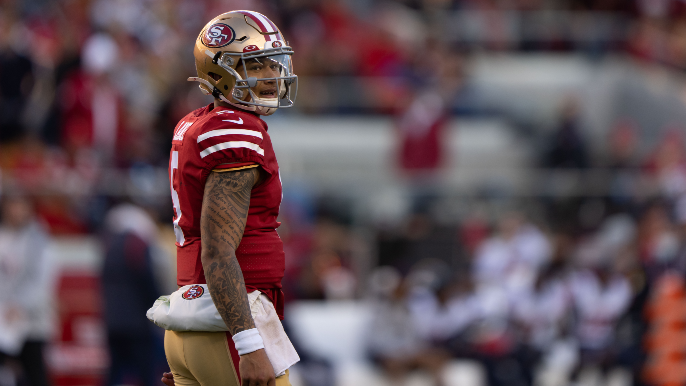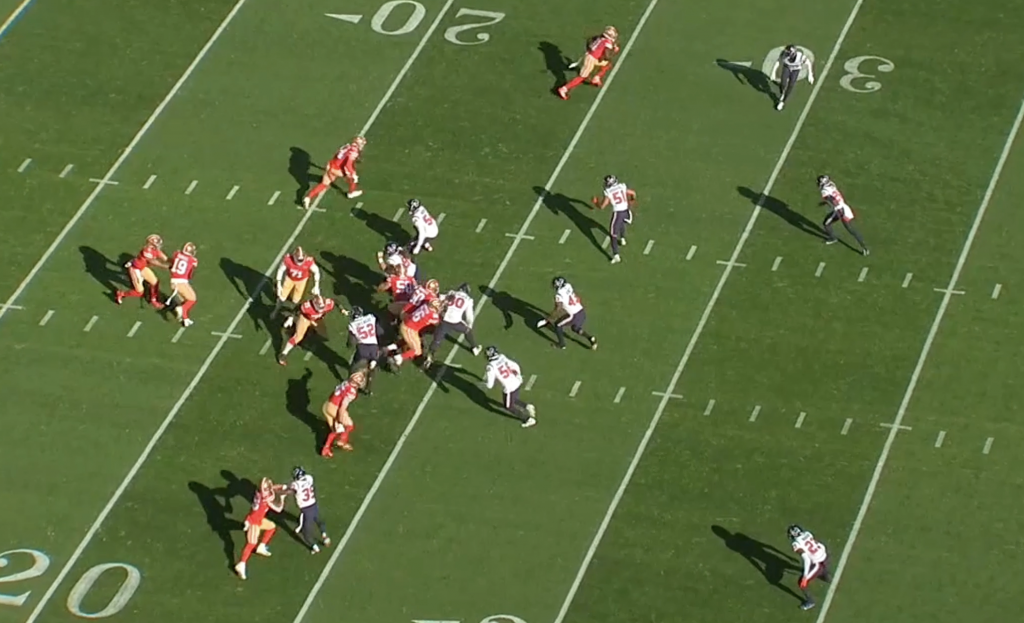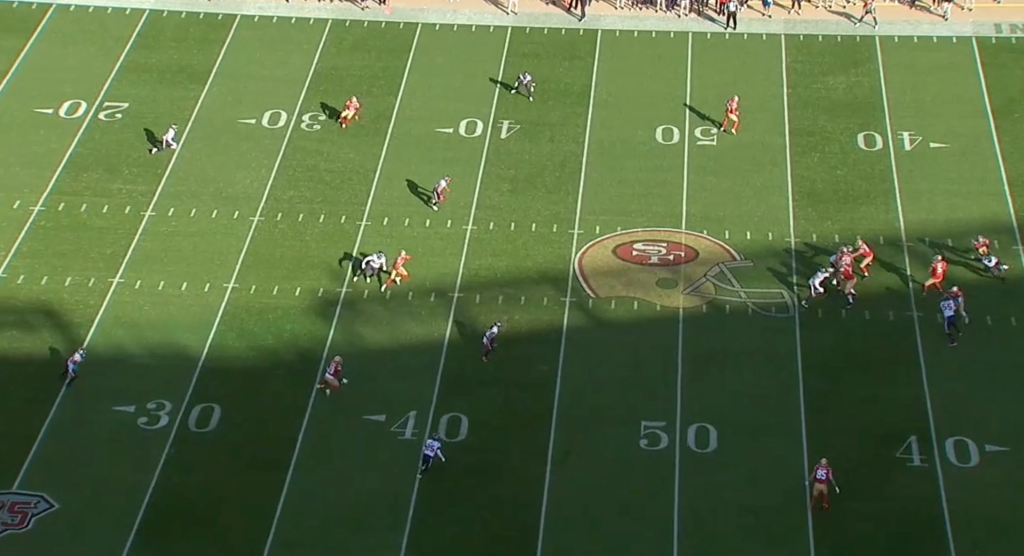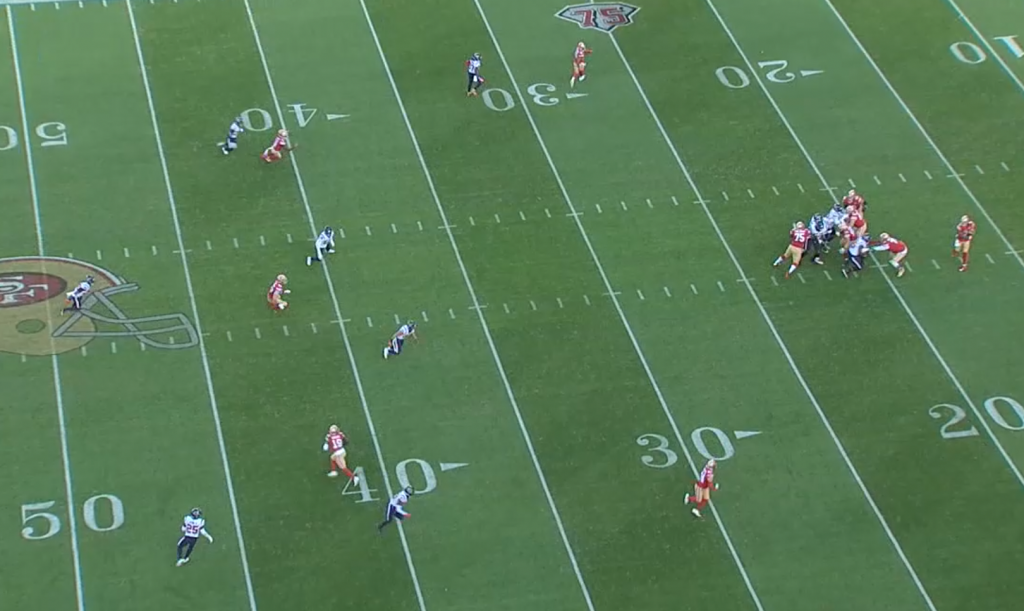
Kyle Shanahan knows who will start at quarterback for the 49ers on Sunday. We do not.
“I know what we’re doing,” Shanahan said. “I just don’t feel like telling you right now.”
It seemed exceedingly unlikely that Jimmy Garoppolo could make it back for this weekend, especially after his whole, “fuck– it hurts” assessment, followed by a description that it felt like the webbing on his hand was tearing.
It seemed like a reasonable indiction that Garoppolo would not play. But after throwing for four-straight days, and tossing his first long ball on Thursday — though it was just one — the momentum has swung in his direction. It might be a toss-up at this point, but Shanahan clearly wants Garoppolo.
The 49ers are certainly leaning into this to keep the Rams off balance, but given that Garoppolo’s past of playing through injury has been decidedly unimpressive, it would be reckless on the 49ers’ part if he started without being near his normal self.
He’s an innately limited quarterback who operates with tenuous margins for error. It’s a needle Shanahan would be trying to thread through a perilously small opening if he does play.
If he doesn’t, the mercurial Trey Lance will get his third career start. It would, for all practical reasons, be a second-straight playoff game, albeit against a Super Bowl-caliber opponent rather than one of the league’s bottom-feeders in the Texans.
But the Texans beat the Los Angeles Chargers — who are in roughly the same situation as the 49ers — a week prior, and you have to evaluate a quarterback’s decision-making and performance independent of the opponent. That said, Lance won’t get away with some of last week’s mistakes against the Rams.
The easiest way to break this down is series-by-series and half-by-half. If you want the Sparknotes version, you can scroll to the bottom for the takeaways.
Some of this may seem harsh or unfairly critical, but you also expect many of these mistakes from a rookie quarterback who has played just three full games over the past two years.
Series 1
Elijah Mitchell opened the game with an uncharacteristic missed read, going outside right guard Daniel Brunskill, instead of cutting back inside for a potential 10-yard run. Instead, it was a 2-yard run, which Shanahan called his only missed play of the day.
The next play was what looked like a poor zone read by Lance. You can see both Trent Williams and Laken Tomlinson pulling to the right, and Texans lineman Jacob Martin holding the left edge. Lance gives to Deebo Samuel, and Martin forces him wide for no gain.
If Lance takes it himself to the right, safety Eric Murray becomes the only player he has to beat to the end zone.

The next play, Lance feels pressure against Tom Compton before it’s there. He turns his hips away from his throwing lane instead of stepping up into the open space ahead of him in the pocket and targeting Brandon Aiyuk. It’s a window which can close quickly, but it’s open and Lance absolutely has the arm to make that throw.
The flip side of this play is that Lance avoided a sack and turned upfield for six yards. If Mitchell makes the right read on the first play, the yardage Lance gains here would’ve been for a first down (though Shanahan probably calls a different play in this circumstance).
In any case, it’s not enough and the 49ers punted.
Series 2
The next series started with Compton again getting his lunch money stolen, though he was excellent as a run blocker in this game. It looked like he was trying to set up to force his man inside to his left and give Lance a lane to his right, but he just got beaten clean inside.
Lance did a great job to escape that pressure and found Mitchell on the checkdown.
The 49ers ran three-straight times after this, with handoff to Kittle, a successful QB sneak, and a chunk run from Mitchell with Kyle Juszcyzk pummeling Neville Hewitt. Here’s that block, in all it’s aesthetic glory.
On the next play, Lance throws a low, wobbly ball to Juszcyk on a rollout. It prevents him from turning upfield, and he’s on the end of a crunching hit this time. It’s just a three-yard gain.
The following two plays are examples of how Lance’s running ability might be a bit overstated. He’s an excellent downhill runner but his lateral quickness and elusiveness leave a lot to be desired. That’s something that was evident even at North Dakota State, but didn’t matter too much against FCS competition, especially given his Ben Roethlisberger-esque ability to shrug off defenders.
He’s used to leaning on his physicality, which is not a viable long-term strategy for self-preservation or success in the NFL.
Both of these plays look like reads. On the first one, he sees the edge defender bite towards Samuel and makes the right read to take it himself. The second one could be argued should go to Mitchell, but neither is a great option.
The greater issue is that he takes two crunching hits on back-to-back plays because he’s a little too patient and either thinks he’s faster than he is, or doesn’t suspect the defensive backs are as fast as they are. Speaking of which, Justin Reid and Desmond King II are stunningly quick.
The lanes aren’t clean in either circumstance, but Lance takes too long to get downhill, especially on the first run. On the second one, Lance either has to hesitate and try and beat Reid to the inside with a move, or sprint flat out to the boundary. He gets stuck in between and both defenders stuff him for a one-yard gain.
After these plays, Shanahan dialed up the 4th-and-1 pitch to Mitchell, which was stuffed by a great play by Houston’s edge, Jacob Martin.
Series 3
After a short run, Lance made one of the plays that define where stands in his development. He has two short slants to his left which are there. He doesn’t take them, but then makes an incredible play to escape the pocket and make a beautiful first-down throw on the run to Aiyuk.
Here’s a timestamped, fantastic breakdown of that play from former NFL quarterback J.T. O’Sullivan, who talked about Lance’s start on KNBR with Dieter Kurtenbach, linked here.
After a chunk run to Samuel, a very similar thing happens. Lance should probably take the immediate short throw to George Kittle, but doesn’t. Instead, he makes a fairly absurd, back-foot throw to Trent Sherfield for an even bigger gain.
This is the thing with Lance. He’s making the wrong decision too often, but turns those mistakes into more productive plays. How does Kyle Shanahan evaluate that? As someone with an excellent scheme, you imagine that he’s both frustrated and impressed.
Meanwhile, Garoppolo’s lack of significant off-schedule ability generally means that Shanahan knows he’ll follow the calls he gives.
After that throw to Sherfield, the 49ers ran three times for 29 yards, followed by a stuffed handoff to Samuel.
Then, Lance was sacked immediately. He had Kyle Juszczyk wide open, but did not have the time to make the throw. The only way he could have made the throw is by seeing the blitzer lined up against Juszczyk coming pre-snap, and identifying that Juszczyk would be uncovered.
Over time, he should be able to identify situations like that, but he gets sacked so quickly here that it seems unfair to blame him.
On the ensuing third-and-19, Lance saw Samuel covered on the left side against Cover-2, then hit Jauan Jennings for a chunk over the middle, but well short of the sticks. He didn’t progress his way to Brandon Aiyuk to his right, who was deeper than Samuel and got open at the sticks.

Lance expected pressure, which came eventually, but he had the time to turn to step up and make the throw to Aiyuk if he worked his eyes over there. There’s even a chance to roll to his right and lead Aiyuk towards the sideline to create more space to take the hole shot.
It’s a tough situation, and that might be nitpicky. The encouraging part of the decision is that Lance gets a substantial completion and doesn’t take his first read after identifying that it’s covered.
Series 4
This is the interception, and it’s ugly. As Lance said after the game, everyone’s probably happy if the ball has more arc to it. But it’s an extremely tight window throw that he admitted he probably shouldn’t try against Cover 2, and his ball came out flat.
Given how much time Lance has in the pocket and the fact that Deebo Samuel is open for a likely touchdown ball, it burns even more. Perhaps the most frustrating part of the throw is that Lance locked onto Kittle immediately after the play action. Had he looked right, he may have found Samuel, or at least softened the coverage for himself to have more space for the throw towards Kittle.
Series 5
This opened with a short run to Samuel, followed by a back screen again to Samuel. Lance maybe took too much time to throw, but Daniel Brunskill slipped at the edge, so the play never stood much of a chance of succeeding.
The third-and-nine throw to Juszczyk followed. Lance didn’t really have any other options and Juszcyzk didn’t have a real chance to get to the sticks after catching it.

There’s possibly a chance for a first down if Lance throws him more towards the field side, but that might leave Juszczyk exposed to the corner who makes the tackle.
Series 6
This is the half-ending field goal drive which began with 38 seconds on the clock and no timeouts.
Lance opened with an immediate, quick slant to Samuel. On the next play, he had Kittle open towards the sideline. He didn’t take it, then got pressured. He waited too long to hit Samuel and threw behind him. This is one of his worst plays given that it burned 10 seconds when the half-ending drive started with just 38 remaining.
The following pass is on time and and right on Aiyuk. The pace gives Aiyuk a split second extra to turn, which he did before getting upfield and out of bounds.
Then Lance launched the deep go to Aiyuk, which is almost perfect from both parties, just against great coverage from Terrance Mitchell.
Then, there was the near interception which Aiyuk somehow managed to catch. It’s at least the right decision, as it looks like he’s reading the sinking corner to determine whether to hit Aiyuk or JaMycal Hasty, but it should have been picked off.
This is one of at least three throws, including the first interception, and a later throw over the middle to Trent Sherfield, which Lance delivered far too flat. The lack of arc and wobbliness on some of his throws is concerning, and opens him up to having his passes tipped or intercepted more often than they should. Luckily the 49ers weren’t punished for it and finished the first half with a field goal.
START OF SECOND HALF – Series 7
This is where things turned around. After a couple pitches, Lance threw an absolute dart to Aiyuk over the middle after manipulating the linebacker, if only for a split second, with his eyes. Aiyuk rumbles on for a 43-yard gain.
Then there’s one of the three flat passes mentioned above. This is tipped by the linebacker because the ball is flat. Lance has Sherfield open.
After a couple quarterback draws got the 49ers into a fourth-and-one situation, there was a play-action boot called. It’s very well covered by Houston and has Kittle, Samuel and Aiyuk as the three-level options.
Kittle is covered and Samuel and Aiyuk get into the same area, with neither in a great position to make a catch. Lance couldn’t find Samuel, but it’s a very tough play. The 49ers were just beat on this one.
Series 8
Lance opened this series with a deep ball to Aiyuk that probably came out a hair late, but somehow reached him despite contact on the throw.
It appeared like the referee may have thrown the flag because of Aiyuk’s protest. Either way, launching deep and trying to draw contact is a legitimate offensive strategy in the NFL, because the onus is on the defender to avoid contact in near-impossible ways. That’s a new wrinkle that’s not usually on the table with Garoppolo at the helm.
After a couple of runs, Lance made a great play to avoid pressure and hit JaMycal Hasty for a first-down conversion.
The following play was the dump pass touchdown to Mitchell, which was as open as it gets.
Series 9
This wasn’t a successful series, but that was of no fault of Lance. He actually made one of his more impressive all-around plays on this series, but was let down by Samuel.
You can see just before the snap, Lance identified the blitz coming from slot corner Tavierre Thomas and calls it out. He throws hot to Samuel on a line, but it’s dropped.
The next play he gets pressured quickly and nearly runs for the first down. He tried to pump fake and freeze the defender who doesn’t bite, and ends up just short of the sticks. It’s hard to criticize him for escaping pressure and nearly running for a first down.
Series 10
This featured two of Lance’s best plays. The first was a low throw to Jauan Jennings. That needs to be corrected. But the anticipation Lance demonstrated was impressive, launching before Jennings came out of his break.
(Timestamped)
Then there’s the touchdown to Samuel. This is just a great throw by Lance and Samuel does the rest.
Series 11
This was the penultimate drive of the day, set up mostly by Elijah Mitchell, but featuring Lance’s best throw by far.
It should also be noted that Michael Dwumfour, number 98 for Houston is a practice squad player who has no business not being on an NFL roster. He showed up on three-straight plays. The first featured an elite get off that Daniel Brunskill stopped well. The following play, he managed to get in the way of both Trent Williams and Kyle Juszczyk, which stuffed Mitchell, and on the third play, he bullied Laken Tomlinson to get in the backfield and force Mitchell wide for no gain.
I’d be remiss if I didn’t credit him. It also set up the lightning bolt throw and catch that effectively sealed the game. It was this rocket to George Kittle, who somehow caught it with one hand while being tackled before the catch. Every part of this is nonsensically good.
Lance had a rushing touchdown taken away three plays later by an Aiyuk hold, and there’s a dicey swing pass to end the drive. Otherwise it was all runs — including the 37-yarder from Mitchell — that don’t involve him.
Series 12
After a couple of carries for Mitchell, Lance ended it with a quarterback dive.
Takeaways
So, what did we learn from all of this?
Lance has a lot of inconsistencies to work out. His throwing motion and footwork isn’t reliable yet. He throws a lot of wobbly and flat balls which have a high probability of being swatted or potentially intercepted. There were at least three flat throws, two of which were near interceptions, and there was the low thrown ball to Jennings.
He doesn’t seem comfortable on short dump throws. He avoided taking a couple to Kittle, got Juszczyk crunched because he underthrew another, and was almost short on the wide open touchdown to Mitchell.
Sometimes he is pre-determining decisions, like with the interception to Kittle. Because he’s getting used to trusting his line in games, it seems like he expects pressure to be there quicker than it is, and misses some opportunities by either not sitting in the pocket or stepping up to throw. With his athletic ability, he has more time than he probably realizes.
The zone-reads don’t look natural or comfortable for him, which explains why Shanahan had him running what seemed like a half-dozen quarterback draws against Arizona. He looks far more confident running vertically than he does horizontally. Perhaps incorporating speed options, which give a pitch option to Lance, with either Samuel or Mitchell flanking him — which would take Lance downhill on the inside run route — would be better uses of him as a runner at this stage in his career.
That’s most of the negatives out of the way. What showed up especially in the second half is that he improves with time and reps, which we all assumed would be the case and is why this season, in which he’s barely played, has been so maddening to watch at times.
He has elite arm talent despite the inconsistencies in his delivery. It showed up with line drives to Samuel, Aiyuk on the short post, the Kittle missile, the deep ball to Samuel and the failed go route to the end zone for Aiyuk.
Because of his talent and athleticism, he can turn potentially bad decisions, like when he didn’t throw short to Kittle, into better plays. Instead of a five-yard touch throw, he adjusted his body after a pump fake and found an immediate first down off his back foot to Sherfield.
He is the uber-talented prospect he was believed to be. And just like everyone understood at the time he was drafted, he needs time to develop. That time has to be on the field in games. Shanahan said himself at the start of this season that the 49ers were intent on making sure Lance would never go another season without playing.
He’s adjusted those parameters to include practice reps, but it’s clear to everyone, and was clear to Shanahan, they are nowhere near as valuable as game reps.
Lance said it himself on Friday, after Shanahan said this week of practice was better than the one preceding it.
“I just think throughout the season, every single rep that I get, I get better,” Lance said. “I think I learn so much from every rep, whether it’s practice or a game.”
Shanahan better hope his gambit of starting Garoppolo results in a playoff berth, because otherwise he’s wasted the majority of a year for Lance’s development for nothing. Mac Jones — obviously a more immediate, plug-and-play, NFL-ready quarterback with a far lower ceiling — showed that rookies on competitive rosters can be successful. We never got a real opportunity to see that with Lance, and his performance last Sunday just leaves you wanting more.

